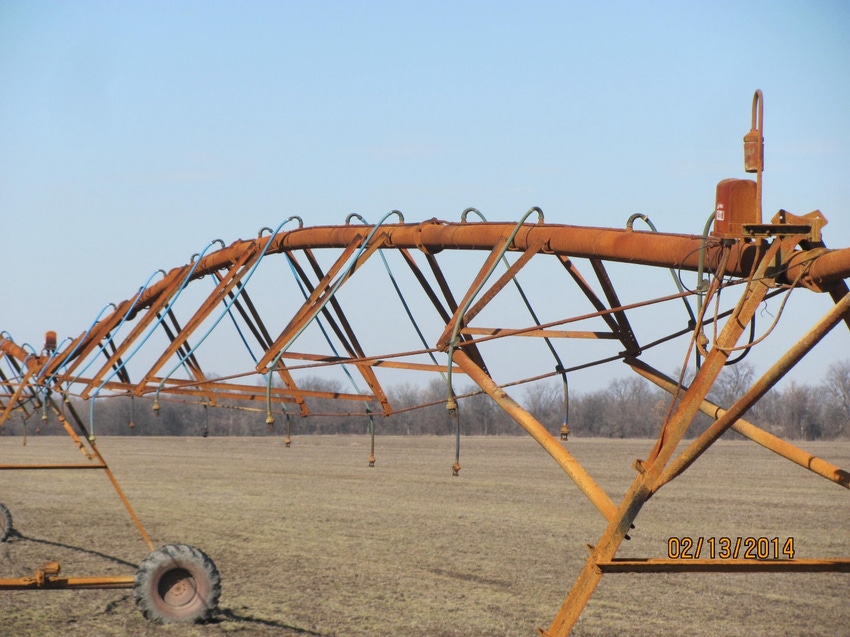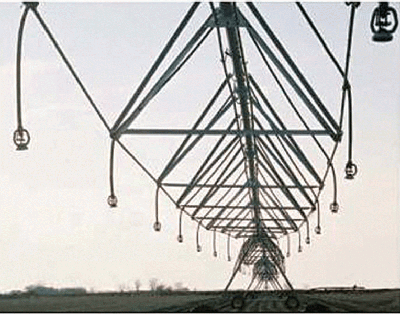
Financial assistance is available to owners and operators of irrigated agricultural land to address water conservation management resource concerns through the Mississippi Water Conservation Management Project, a voluntary conservation program.
“Assistance is provided through the Natural resources Conservation Service (NRCS) Environmental Quality Incentives Program (EQIP),” says Paul Rodrigue, NRCS supervisory engineer located at Grenada, Miss.

Adding new nozzles and drops can help conserve agricultural water resources. Financial assistance for the upgrades can be applied for through NRCS.
“The program is geared to assist with management practices that help solve serious water quantity and quality issues in counties that fall into the Mississippi River Valley Aquifer (MRVA),” he says. To be considered for assistance, the land associated with a program application must be located within the MRVA and qualify through the EQIP.
Counties in Mississippi that are in the MRVA area and eligible for assistance are Bolivar, Carroll, Coahoma, Desoto, Grenada, Holmes, Humphreys, Issaquena, Leflore, Panola, Quitman, Sharkey, Sunflower, Tallahatchie, Tate, Tunica, Warren, Washington, and Yazoo.
“Approved land type eligible for this initiative,” Rodrigue notes, “is irrigated agricultural land. The land must have been irrigated two out of the last five years. Row, sprinkler, flood, and aquaculture are acceptable irrigation methods.”
THESE ARE PRACTICES THAT ARE ELIGIBLE
Contracts developed under MWCMP must include acres classed as 449 Irrigation Water Management and a non-449 practice. The non-449 practices are:
442 Irrigation System Sprinkler (renovation and PAM injector pump scenarios)
443 Irrigation System, Surface and Subsurface (surge valve scenario only)
450 Anionic Polyacrylamide Application (PAM)
533 Pumping Plant (PAM injector pump and pump automation scenarios)
587 Structure for Water Control (flowmeter scenarios)
“Many existing center pivot systems were planned on a 0.25 inch per day irrigation demand,” Rodrigue says. “With changes in crops, this may not be sufficient. Renovating your pivot with new nozzles on drops can increase the application efficiency of the pivot, so the system can meet the needed irrigation demand. And by keeping the pivot in place, you will help to insure the most efficient use of the Delta’s groundwater resources.”
For financial assistance, drops must extend below structural components of the pivot and be on the outside of the truss rod. Single drops must alternate sides of the pivot. New nozzles must also be installed
SIGNUP PROCESS
“The newer nozzle packages have improved distribution patterns,” Rodrigue points out, “and by alternating sides of the pivot, the application time is lengthened so the application rate, equivalent inches per hour, will not typically exceed the intake rate of the soil.”
The first step in seeking financial assistance from NRCS, he says, is to have an application in place for the current year. “NRCS has a continuous signup, so you can put in an application at any time. However, each program has a separate application deadline for its ranking pools. The MWCMP application deadline will be announced at a later date.”
442 Pivot Renovation is also available under the general EQIP program, Rodrigue says. “It has a Nov. 18, 2016, application deadline for the first ranking pool and a Jan. 20, 2017, application deadline for the second ranking pool. If you have an application on file by Nov. 18, it will be used for the remainder of the year for other programs and ranking pools as they become available.
“I would also encourage all pivot operators to place a minimum of two rain gauges under the last span of their pivot and measure their application at least once a year. This will allow them to keep track of any performance changes in their pumping plant or pivot system.”
About the Author(s)
You May Also Like




